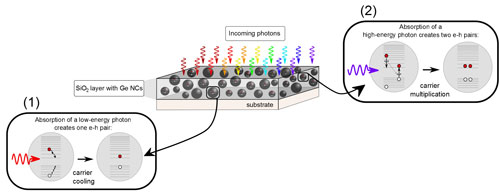| Posted: Feb 14, 2015 |
Getting 2 for 1: 'Bonus' electrons in germanium nanocrystals can lead to better solar cells
|
|
(Nanowerk News) Researchers from FOM, the University of Amsterdam, the Delft University of Technology and the University of the Algarve have discovered that when light hits germanium nanocrystals, the crystals produce 'bonus electrons'. These additional electrons could increase the yield of solar cells and improve the sensitivity of photodetectors. The researchers published their work in Light: Science & Applications on 13 February 2015 ("Carrier multiplication in germanium nanocrystals").
|
 |
| Carrier multiplication. The material is illuminated with photons. In some of the germanium nanocrystals, the photons cause electrons to be excited, and thus form an electron-hole (e-h) pair. There are two possibilities. (1) The incoming photon has an energy in the range between once and twice the bandgap energy. One e-h pair is formed. (2) The incoming photon has an energy of more than two times the bandgap energy. The excess energy of the electron – the ‘kinetic’ energy of the electron which is excited high up in the conduction band – is sufficient to create a second e-h pair in the same nanocrystal. In that way, carrier multiplication is achieved. (click on image to enlarge)
|
|
In nanocrystals, the absorption of a single photon can lead to the excitation of multiple electrons: two for one! This phenomenon, known as carrier multiplication, was already well known in silicon nanocrystals. Silicon is the most commonly used material in solar cells. However, the researchers found that carrier multiplication also occurs in germanium nanocrystals, which are more suitable for optimizing the efficiency than silicon nanocrystals. Their discovery could lead to better solar cells.
|
|
Semiconductor physics
|
|
Germanium and silicon are examples of semiconductors: materials that have an energy bandgap. When these materials absorb light, electrons from the band below this energy gap (valence band) leap to the band above the gap (conduction band). These excited ‘hot’ electrons and the holes they leave behind can be harvested to form an electrical current. They form the basic fuel for a solar cell.
|
|
Nanocrystals and carrier multiplication
|
|
If an absorbed photon contains more energy than an electron requires to leap over the bandgap, the excess energy can be used to excite a second electron. Earlier research has shown that a bandgap energy from 0.6 to 1.0 electronvolts is ideal to achieve this carrier multiplication.
|
|
Nanocrystals are extremely small, about a thousand times smaller than the width of a human hair. Due to their size, the energy structure of the crystals is dramatically different from that of bulk material. In fact, the bandgap energy depends on the nanocrystal size. Bulk germanium has an energy bandgap of 0.67 electronvolts. By tuning the germanium nanocrystals' size, the researchers can change the bandgap energy to values between 0.6 and 1.4 electronvolts. This is within the ideal range for optimizing carrier multiplication, or the amount of 'bonus electrons'.
|
|
Performing the experiment
|
|
To investigate carrier multiplication in nanocrystals, the researchers used an optical technique called pump-probe spectroscopy. An initial laser pulse, called the pump, emits photons that excite the nanocrystal by creating one free electron in the conduction band. A second pulse of photons, called the probe, can then be absorbed by this electron.
|
|
The researchers found that if the energy of the pump photon is twice the bandgap energy of the germanium nanocrystals, the probe light is absorbed by two electrons instead of one. This effect is the well-known fingerprint of carrier multiplication. In other words, if the pump photon carries sufficient energy, the hot electron contains enough excess energy to excite a second electron in the same nanocrystal. Using this carrier multiplication, germanium nanocrystals can help achieve the maximum efficiency of solar cells.
|

